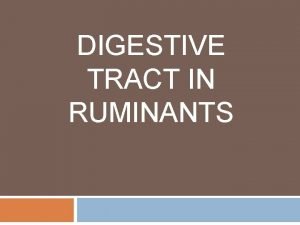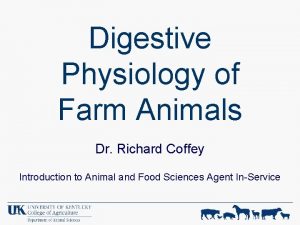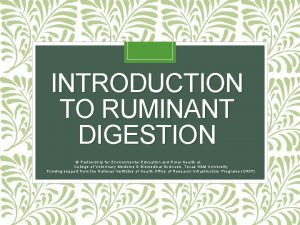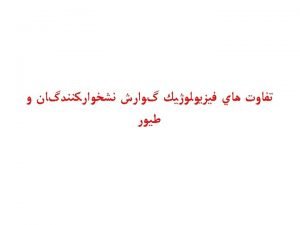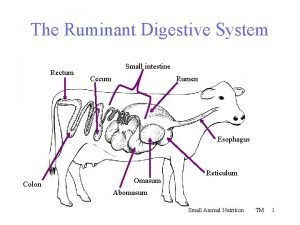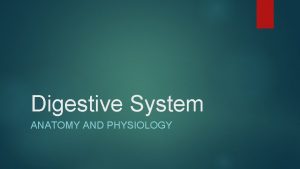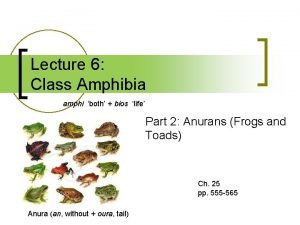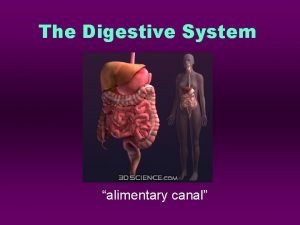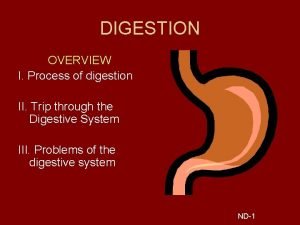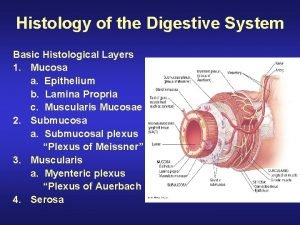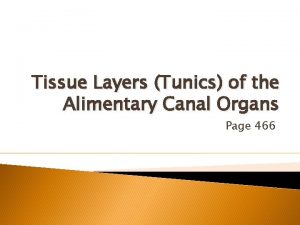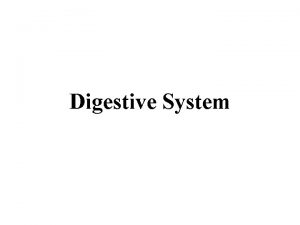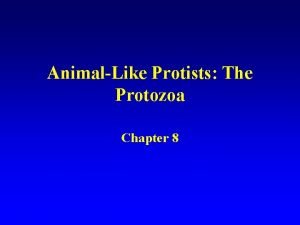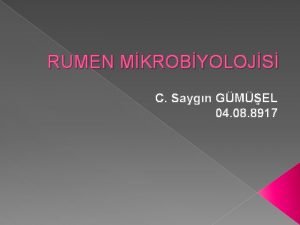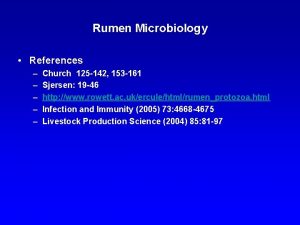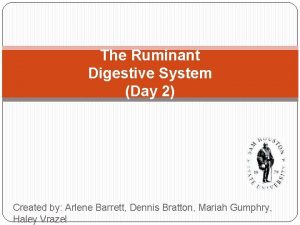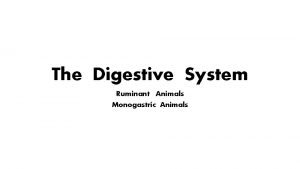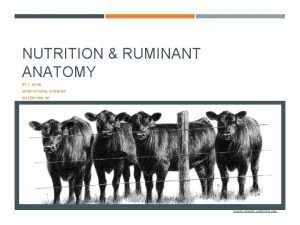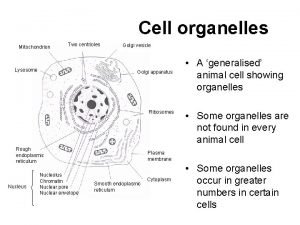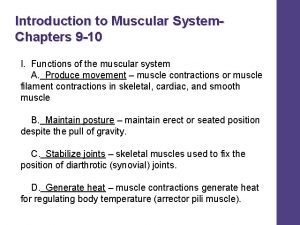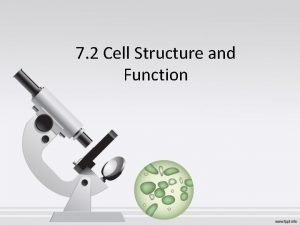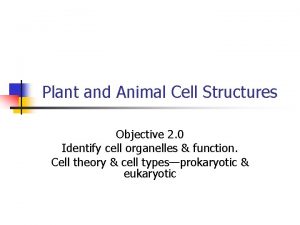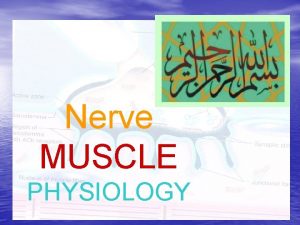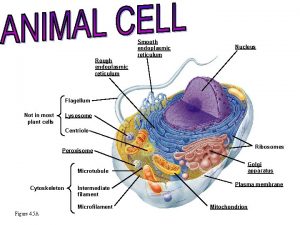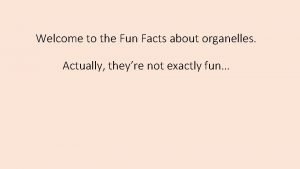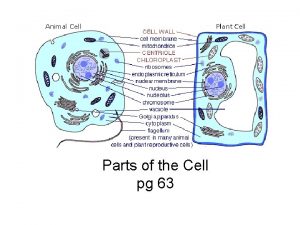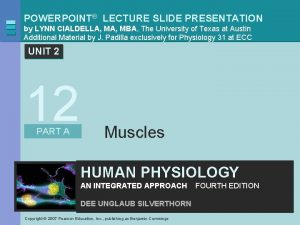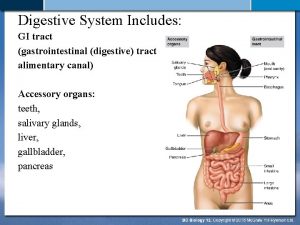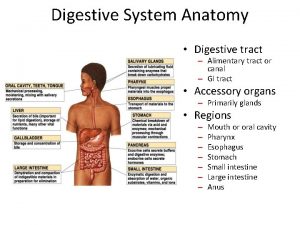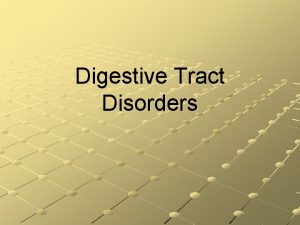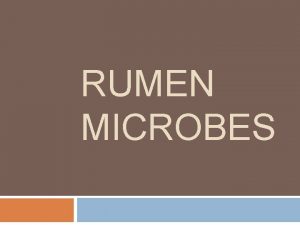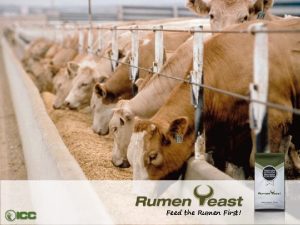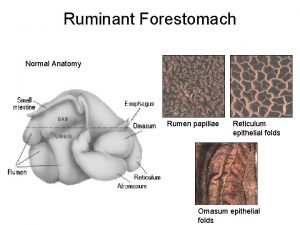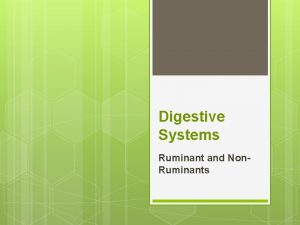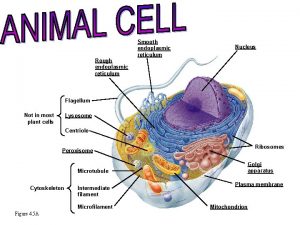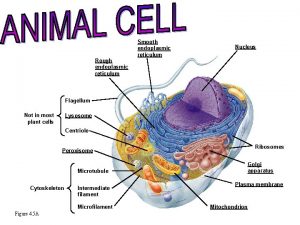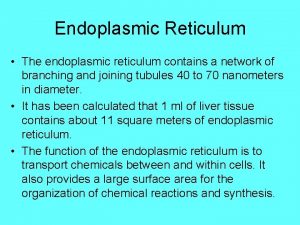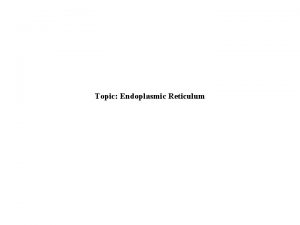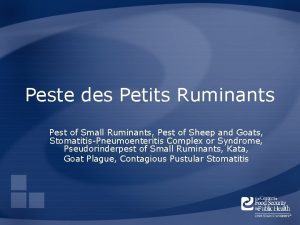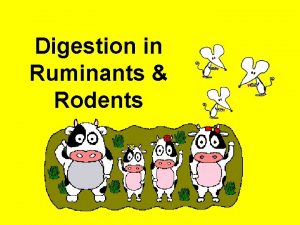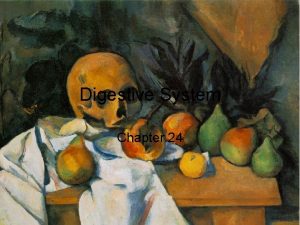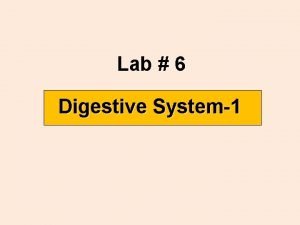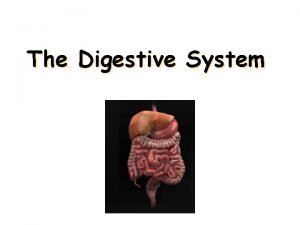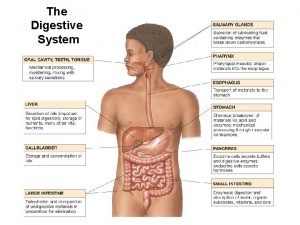DIGESTIVE TRACT IN RUMINANTS Ruminants Reticulum rumen omasum




































- Slides: 36

DIGESTIVE TRACT IN RUMINANTS

Ruminants Reticulum, rumen, omasum, abomasum Pseudo-ruminants: camel w/ three compartments. Extensive pre-gastric microbial fermentation (60 % to 75 %) Stomach is ~26% of body weight compared with 4% in swine

Mouth Tongue � More used by cattle & goats (also lips) Teeth � No upper incisors � Used more by sheep (use lips more to sort) Saliva � Continual production � Cattle: 12 -15 gal/d; sheep: ~2 gal/d � No enzymatic function; adjusting p. H (alkaline)






Esophagus No sphincter valve Opens into reticulum & rumen Muscle contractions, move in both directions

Reticulum Lies against the diaphragm and is the most cranial component. AKA the “honeycomb”: -Lined with mucous membrane containing many intersecting ridges which subdivide the surface into many folds that form polygonal cells that give it a reticular, honeycomb-like appearance. This increases surface area of organ for increased digestion. Serves as a protection mechanism: Heart can be damaged by appositional location next to heart by “Hardware Disease. ” Stratified squamous epithelium. No enzyme secretion

Reticulum Honeycomb appearance Hardware problems (magnets) Muscular for eructation and milk groove.

Rumen The largest of the forestomachs extending from the diaphragm to the pelvis and almost entirely filling the left side of the abdominal cavity. Sacculated by muscularis pillars into what are known as the dorsal, ventral, caudodorsal, and caudoventral sacs. Many times the reticulum is considered a fifth cranioventral sac because ingesta flows freely between these two organs. The surface is covered by a stratified squamous epithelium.

Rumen Epithelium

Ruminants Cellular lining of first three stomachs is stratified squamous epithelium not typical of absorption sites however it is only two layers thick so some compounds can be absorbed.

Growth & development of digestive tract

Early stages The abomasum is the largest component (~ 50% of total weight) Feeding dry feed causes rapid growth in weight, volume, musculature & absorptive capacity Rumen growth: VFAs, resident dry feed


Reticular groove Reflex; Suckling process; chemical stimulation Lips closing to form a canal to bypass reticulorumen milk through omasal groove to the abomasum

Growth and development of the rumen Sources of rumen microbes: surrounding environment � Feces � Saliva Over a 4 wk period, grows 4 -8 X � Rumen papillae � Forage intake

Relative size of stomach compartments; birth to maturity

Motility Mixing Regurgitation Pushing food to omasum Overall, circulates digesta within the reticulorumen (~ 40 s in resting)

Rumen Gas Upper part of the dorsal rumen Mainly CO 2 (0. 67 -0. 75 of total) and CH 4 Minor: N, O 2, H, HS 2 Mostly eliminated via eructation Also, across rumen wall (CH 4) Bloat: failed eructation � Legume bloat � Feedlot bloat

Reticulum Physiology Regurgitation is initiated with a reticular contraction. Heavy objects (grain, rocks, nails) fall into the reticulum while lighter materials such as grass and hay enter the rumen Gases flow from the rumen into the reticulum and eructation or belching occurs with a reticular contraction to rid of the fermentation gases.

Rumen Largest Papillae, tongue-like projections Extensive blood supply Density and size of papillae differ in locations and in different species. Muscular pillars divide it into several sacs contract in a rhythmic manner mixing the ingested feed with rumen contents.

Rumen Physiology Enormous space filled with chewed and halfchewed material that the animal has ingested, swallowed, regurgitated, and swallowed again. “Chewing Cud” Nutrient absorption occurs here despite the presence of keratinized, stratified, squamous epithelium.


Rumination Process of regurgitation of ingested feed for further mastication Undigested coarse feed collects in reticulum and is send back up the esophagus. Eight hours/day; function of diet

Rumination Regurgitation of ingesta: � Mastication � Reforming the bolus � Re-swallowing Reticulo-rumen contents esophagus mouth Scratch factor: forage diets vs. concentrate diets


Functions Storage Soaking Physical mixing & breakdown (physical digestion) Fermentation (breakdown fibrous particles) � Volatile fatty acids � Vitamins � Amino acids

Rumen Physiology The by-products of fermentation that results from the microorganisms are fatty acids and gases in the form of CO 2 and methane. These gases rise to the top of everything. Gases Today’ s grain Yesterday grain and hay


Saliva Ruminants produce 100 -150 L/d Serves two important functions: A. Provision of fluid for fermentation B. Alkaline buffering which is critical for rumen p. H. Feed, water and saliva are delivered to the reticulum through the esophageal orifice.

Saliva p. H: 8. 1 DM: 1. 3% Ash: 0. 97% Na: 352 -447 mg/100 m. L K: 12 -45 mg/100 m. L N: 16 -35 mg/100 m. L P: 19 -129 mg/100 m. L Ca: 0. 8 mg/100 m. L Mg: 0. 8 mg/100 m. L

Saliva and salivary glands In ruminants, no digestive enzymes Fluid: transport Adequate phosphate; cellulose degradation Buffer: neutralize low p. H created by FA (e. g. , lactic acid) Glands: The biggest is mandibular The most important one is the parotid: Alkalinity

 Rumen omasum abomasum reticulum
Rumen omasum abomasum reticulum Ruminant stomach parts
Ruminant stomach parts Digestive system of ruminant
Digestive system of ruminant Digestive system of ruminants
Digestive system of ruminants Cow digestive system
Cow digestive system Digestive system of ruminants
Digestive system of ruminants Pyramidal vs extrapyramidal tract
Pyramidal vs extrapyramidal tract Dorsal reticulospinal tract
Dorsal reticulospinal tract 6 steps of digestion
6 steps of digestion Digestive tract order
Digestive tract order Digestive system histology
Digestive system histology Pathway that food takes through the digestive system
Pathway that food takes through the digestive system Common bile duct empties into
Common bile duct empties into End of the digestive system
End of the digestive system Histology of digestive tract
Histology of digestive tract Cnidarian digestive system
Cnidarian digestive system Tissue layers of the alimentary canal
Tissue layers of the alimentary canal General structure of digestive tract
General structure of digestive tract Axopodia
Axopodia Rumen radav
Rumen radav Rumen mikroorganizmaları
Rumen mikroorganizmaları Monensin
Monensin Digestion microbienne chez les ruminants
Digestion microbienne chez les ruminants Define ruminant digestive system
Define ruminant digestive system Animali monogastrici
Animali monogastrici Four chambers of ruminants
Four chambers of ruminants Mitochondria layers
Mitochondria layers Introduction of endoplasmic reticulum
Introduction of endoplasmic reticulum Sarcoplasmic reticulum
Sarcoplasmic reticulum E.r function
E.r function Nucleous
Nucleous Smooth endoplasmic reticulum function
Smooth endoplasmic reticulum function Smooth muscle myosin
Smooth muscle myosin Smooth endoplasmic reticulum
Smooth endoplasmic reticulum Facts about organelles
Facts about organelles Nucleolus nickname
Nucleolus nickname Transverse tubules and sarcoplasmic reticulum
Transverse tubules and sarcoplasmic reticulum
